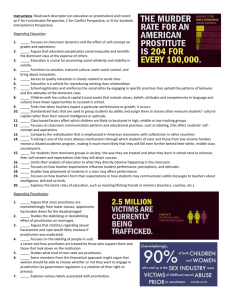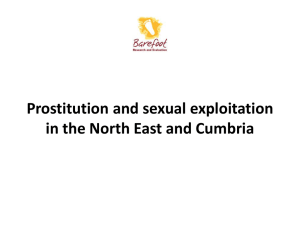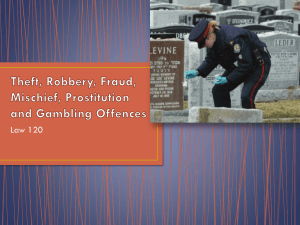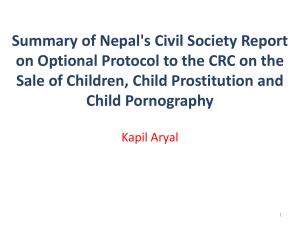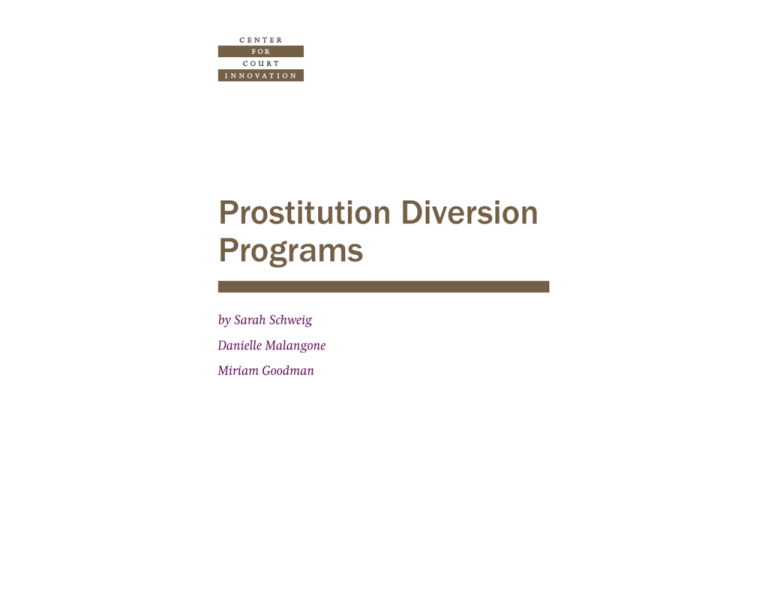
Prostitution Diversion
Programs
by Sarah Schweig
Danielle Malangone
Miriam Goodman
1
Prostitution Diversion Programs
The winner of the Peter F. Drucker Award
for Non-profit Innovation, the Center for
Court Innovation is a unique public-private
partnership that promotes new thinking
about how the justice system can solve difficult problems like addiction, quality-of-life
crime, domestic violence, and child neglect.
The Center functions as the New York State
court system’s independent research and
development arm, creating demonstration
Prostitution Diversion Programs
projects that test new approaches to problems
that have resisted conventional solutions.
Nationally, the Center disseminates the
lessons learned from its experiments in New
York, helping court reformers across the
country launch their own problem-solving
innovations. The Center contributes to the
national conversation about justice through
original research, books, monographs, and
roundtable conversations that bring together
leading academics and practitioners. The
Center also provides hands-on technical
assistance, advising innovators across the
THE PROBLEM
Many communities across the country grapple with
how best to respond to prostitution. Traditionally,
some community members end up directing their
outrage at the women and girls they see walking
the streets, rather than the less visible pimps and
traffickers.
country and around the world about program
and technology design.
For more information, call 646.386.4186 or
e-mail info@courtinnovation.org.
2012
In an area of the Bronx, for example, community
members have been struggling for years to eradicate
a hot spot of prostitution that is in clear view of an
elementary school. “It hurts that we have to be going
through this right in front of the school,” said Tamika
Salichs, a mother of two children at the school, in a New
York Times article about the problem.
Law enforcement is often as frustrated as local
residents are. “We can’t pick them up for just standing
on the street,” said Officer Tony DiGiovanna of the NYPD.
“A lot of times we bring them in, they get a slap on the
wrist, and they’re back on the street the next day.”1
1
A Bronx Elementary School, Surrounded by Prostitutes. http://www.
nytimes.com/2011/01/03/nyregion/03bronx.html?scp=1&sq=a%20bronx%20
2
CENTER FOR COURT INNOVATION
In recent years, the problem of prostitution has only
gotten more complex. In many places street prostitution
has morphed into more organized, covert hotel and
massage parlor operations that exploit both domestic
and international trafficking victims. Advances in
technology have allowed pimps and traffickers to
coordinate their operations online. This has had the
benefit of hiding prostitution from the community,
but it comes at a cost: the further isolation of exploited
women and girls.2
THE IDEA
People arrested for prostitution tend to cycle through
the justice system again and again. Recognizing this,
some justice practitioners are trying new approaches—
rather than fines and jail time—to address the problems,
such as trauma, abuse, and drug addiction, that keep
many women and girls in “the life” of prostitution.
While prostituted populations are not limited
to women and girls, this paper focuses on diversion
programs in the New York City area that are working
primarily with female populations.
“I think many still don’t realize how widespread
coercion is,” said Kate Mogulescu, a Legal Aid attorney
whose clients include those arrested for prostitution. “I
think we’re still in a place of thinking that coercion only
involves foreign-born women who are smuggled here.
But there are many domestic cases of sex-trafficking as
well.”
“The average age where a girl is forced into
prostitution is 12 to 14,” Lauren Hersh, a prosecutor in
Brooklyn, told The New York Times.3
2
3
elementary%20school,%20surrounded%20by%20prostitutes&st=cse
As Other Crimes Recede, Street Prostitution Keeps Its Wily Hold. http://www.
nytimes.com/2012/02/13/nyregion/as-other-crimes-recede-police-crack-downon-street-prostitution.html?_r=1&nl=nyregion&emc=ura1&pagewanted=all
How Pimps Use the Web to Sell Girls. http://www.nytimes.com/2012/01/26/
opinion/how-pimps-use-the-web-to-sell-girls.html?_r=1
3
Prostitution Diversion Programs
“We as a society, and especially those within the legal
and social services communities, must begin thinking
and talking about prostitution differently,” said
Sarah Dolan of Sanctuary for Families, a non-profit
domestic violence organization. “We need to
“We as a society, and
recognize that arrest and prosecution only
especially those within the
further stigmatize and punish women whose
legal and social services
exploitation in prostitution reflects their lack
communities, must begin
of choice.”4
thinking and talking about
The Midtown Community Court has found
prostitution differently.”
that over 80 percent of the women arrested for
—Sarah Dolan,
prostitution in Manhattan report some form
Sanctuary for Families
of past or present victimization, including
childhood sexual abuse, sexual and/or physical
assault, or domestic violence. Although these women
enter the criminal justice system as defendants, many
frontline criminal justice practitioners have come to
recognize that they suffer from chronic and complex
traumatization—many were even trafficked as children.
Several courts in New York have created special
programs that combine comprehensive assessments,
court monitoring, and an array of supportive services.
The idea is that by linking victimized women to services
and support, the justice system can potentially help
them build new lives. As Judge Fernando Camacho of
Queens, New York, put it, “The goal is to give prostitutes
an opportunity to get out of ‘the life.’”
4
Sarah Dolan, Advocate Counselor, Sanctuary for Families, Testimony before
the New York City Council, June 27, 2011. http://changingthecourt.blogspot.
com/2011/06/stars-counseloradovcate-testifies.html
4
CENTER FOR COURT INNOVATION
HOW IT WORKS
Street prostitution was a significant problem in Midtown
Manhattan when the Midtown Community Court
opened in 1993. “It was very visible,” said Courtney
Bryan, the project’s director. “The court quickly
recognized that people arrested for prostitution had
all kinds of social service needs, which included drug
treatment, employment services, and housing.”
In response, staff at the Midtown Community Court
developed the Services to Access Resources and Safety
(STARS) program in 2009 to address the physical, sexual,
and emotional violence that many prostituted women
experience. The STARS program is designed as an
alternative to jail. Court-based case managers/women’s
specialists screen each client, looking for histories of
trafficking and underlying trauma and then connecting
participants to appropriate services, including domestic
violence and sexual assault services provided by on-site
partners.
The program is psycho-educational, applying
evidence-based interventions to help women escape
exploitation and avoid re-arrest. “What we’ve done
is taken a trauma-informed approach, which means
meeting your clients where they are,” said Miriam
Goodman, Midtown’s clinical director. “The number
one thing they are taught by their pimps is not to talk
to anyone, and we say ‘Talk about it.’” During the initial
assessment, social workers seek to engage clients and
build trust while gathering information.
Over time, the Midtown Community Court has
found that many women involved in prostitution are
surrounded by unsafe and antisocial relationships.
Court-based social workers counsel clients individually
to encourage them to make a change in their lives,
whether big or small.
5
Prostitution Diversion Programs
A centerpiece of STARS is a multi-session counseling group
that covers the following topics:
— Orientation and Stereotypes. Group rules, purpose, and
expectations are established during the first session. The session
names and explores stereotypes and judgments that society has
about prostitution to normalize clients’ experience, and provide an
outlet for potential anxiety about being judged by participants and
counselors in the group.
— Safety. This session focuses on defining the concept of safety within
the life of prostitution. Clients are asked to explore safe/unsafe places,
people, and actions in their own lives.
— Trauma and Affect Regulation/Relaxation. A psycho-educational
overview of trauma, trauma reactions, and trauma triggers is provided
to clients. The second part of the session models relaxation techniques
that assist clients in learning to control their physiological trauma
reactions.
— Arts Education. Through a partnership with a local arts and cultural
institution—the Museum of Modern Art in Manhattan—clients engage
in creative outlets including workshops and museum tours.
— Feeling Identification. Clients learn to identify different feelings and
to distinguish between internal and external feelings through the
creation of an “inside of me/outside of me” feeling box. This exercise
allows clients to begin to discuss their feelings in a group setting safely.
— Legal Issues. Criminal and immigration attorneys lead educational
workshops to help clients understand their legal rights and the
consequences of criminal activity.
— Financial Literacy. A session to promote economic self-sufficiency,
clients explore such topics as basic banking, budgeting, and
establishing/repairing credit. Pro bono financial planners and partner
agencies can assist with individual financial counseling.
— Cognitive Restructuring. Clients explore the connection between
their thoughts, feelings, and actions, and begin to practice new ways
of thinking.
— Healthy Relationships and Setting Boundaries. This session addresses
the difficulty in establishing boundaries in relationships. Clients are
able to discuss and explore the types of relationships and boundaries
that exist in their lives, and how they relate to their safety.
6
CENTER FOR COURT INNOVATION
One Case
Lizzie was sexually abused from age 2 to12 by her
stepfather and others, and physically and emotionally
abused by her mother. Lizzie was 12 when Lizzie’s
mother kicked her out. With no money, no food, and
nowhere to go, Lizzie became involved with a pimp and
entered the life of prostitution. 20 years later, Lizzie was
homeless, struggling with addiction, and had
been arrested over 100 times.
“The social workers in the
For many experts who work with women
STARS program…helped me
and girls in prostitution, Lizzie’s story is
realize that I needed to make
typical. “The multiple experiences of sexual
changes in my life.”
abuse at such a young age ingrained in her a
—Lizzie
belief that she was worth nothing; this is very
common with survivors of childhood sexual
abuse.” said Miriam Goodman, clinical director at the
Midtown Community Court. Midtown was the first court
to treat Lizzie as a victim. The court linked her with
mental health and career counseling and helped her get
on a path to leave the life of prostitution.
“What made the Midtown Community Court
different from the other courts that I’ve been to is that
they offer individual therapy,” said Lizzie. “The social
workers in the STARS program…helped me realize that I
needed to make changes in my life.”
Lizzie got a job and moved into a reunification
shelter for mothers and children. “With the help and
the support that I had with Midtown Community Court,
I made some wonderful steps,” Lizzie said.
7
Prostitution Diversion Programs
CHALLENGES
Because of the complex issues this population faces,
prostitution diversion programs have found they need
to measure success in a variety of ways, and not just
through recidivism.
“You have to look at how many have orders of
protection against their traffickers, how many have
jobs, how many have a place to live,” said Sarah Dolan
of Sanctuary for Families, who added that measuring
only recidivism may not provide an accurate picture of
the strides these women and girls make in diversion
programs.
“I measure success in multiple ways,” added Miriam
Goodman. “If a woman calls our program just to check
in: success. If a woman decides she wants to get out of
the life: success. I think a lot of programs are set up
to remove the women from the life of prostitution as
quickly as possible, and that’s almost a set up for failure.
It doesn’t happen overnight. But over the long term this
program can make a difference.”
Responding to Non-Compliance
Ultimately, the goal of the diversion programs is to
reduce the justice system’s use of incarceration as a
response to prostitution and help victimized
women leave the life of prostitution.
“The goal is to give these kids
“Prostitution is a class B misdemeanor. It’s
an opportunity to get out of
a crime. But every case is different,” said
‘the life.’”
Kimberly Affronti of the Queens County
—Judge Fernando
District Attorney’s Office.
Camacho
Diversion programs take into account the
numerous barriers that prostituted women
face that make compliance difficult. Just as addicts often
suffer relapses before successfully achieving sobriety,
women and girls arrested for prostitution may continue
to get arrested before they achieve safety.
8
CENTER FOR COURT INNOVATION
“Because of the complexities of these situations, it
requires multiple engagements for most people,” said
Courtney Bryan.
At the Midtown Community Court, staff review
cases weekly, including reports from partner agencies,
so that they can respond immediately if a client is
non-compliant. If defendants do not comply with
the mandate, the judge often uses a set of graduated
sanctions to encourage compliance, such as adding
services or increasing the frequency of court visits.
Meeting with staff regularly, as well as returning to
court to see the judge, provides a support system that
gives prostituted women an opportunity to sever ties
with pimps and traffickers. “For me, being in front of
the Midtown judge was a great eye opener,” said Lizzie.
“He gave me another chance.”
9
Prostitution Diversion Programs
ADAPTATIONS
Courts in Queens and the Bronx have also implemented
programs to help women and girls leave the life of
prostitution.
Bronx Community Solutions
Bronx Community Solutions, which offers alternatives
to incarceration for misdemeanor offenders in the
Bronx, worked to adapt the STARS program model.
The first step was to collaborate with the district
attorney’s office to encourage consistency. “We tried to
have all prostitution cases come before the same judge,”
said Maria Almonte, the project director of Bronx
Community Solutions. “This provides consistency for
individuals with otherwise tumultuous lives, aids them
in accessing services, and helps ensure accountability.”
Bronx Community Solutions focuses its efforts on five
police precincts in the Bronx where prostitution is most
problematic. “It’s become institutionalized that these
cases are referred to us,” Almonte said.
Bronx Community Solutions has partnered in
this effort with Sanctuary for Families, a non-profit
that works with victims of domestic violence and sextrafficking victims and the victims’ children. A resource
coordinator from Bronx Community Solutions stationed
in the courtroom flags potential cases, and then a
caseworker conducts an individualized needs assessment
to determine which services would be most helpful. An
advocate counselor from Sanctuary for Families provides
follow-up counseling and links to other services.
Sarah L. Dolan, the advocate counselor, said that
having an intermediary between the client and the
court ensures that clients with histories of victimization
do not feel further threatened by the justice system.
“The clients have an advocate there seeing them
throughout the entire process. That we are located right
in the court is critical,” she said.
10
CENTER FOR COURT INNOVATION
The Queens County Prostitution Diversion Court
The Queens program developed through a slightly
different course than the diversion programs in
Midtown and the Bronx. The Queens model developed
by Judge Fernando Camacho—and now led by Judge Toko
Serita—was developed before the STARS program, relying
on off-site service providers such as Girls Educational
& Mentoring Services, Sexual Assault and Violence
Intervention Program, and the New York Asian Women’s
Center.
When Judge Fernando Camacho saw the same
women and girls cycling through the system and getting
short stints in jail, he started looking for another way.
“It became clear to me,” Judge Camacho said, “that once
they were on the street, on the track, and in the life, it
was not so easy, if not downright impossible for them to
leave.”
Where Midtown developed specific programming
in the court, Queens tapped into preexisting service
providers in the community and integrated them into
the process. Now all prostitution cases in Queens are
handled by the same judge, Judge Toko Serita, and a
dedicated prosecutor.
“The goal is to give these kids an opportunity to get
out of ‘the life,’” Judge Camacho said.
11
Prostitution Diversion Programs
TECHNICAL ASSISTANCE
Since 1996, the Center for Court Innovation has helped
dozens of jurisdictions develop programs that respond
to violence against women, whether domestic violence,
sexual assault, or prostitution and trafficking.
The Center for Court Innovation is able to provide a
variety of services, including on-site support, site visits
to prostitution diversion courts, peer-to-peer contacts,
and planning materials.
For more information about planning and
implementing a prostitution diversion court contact
the Center for Court Innovation at expertassistance@
courtinnovation.org or 646.386.3100.
12
CENTER FOR COURT INNOVATION
About the Authors
Sarah Schweig is senior communications associate at the Center
for Court Innovation. Danielle Malangone is associate director of
National Technical Assistance and formerly deputy director of the
Midtown Community Court. Miriam Goodman is clinical director of
the Midtown Community Court.
Center for Court Innovation
520 Eighth Avenue, 18th Floor
New York, New York 10018
P.
646.386.3100
F.
212.397.0985
courtinnovation.org



